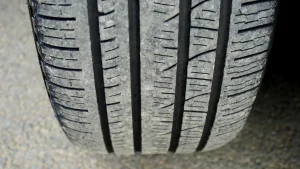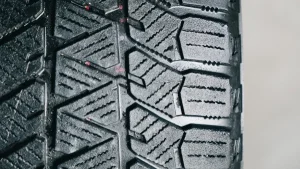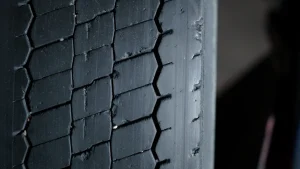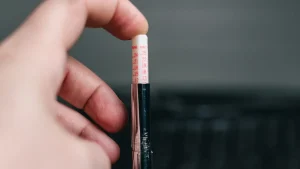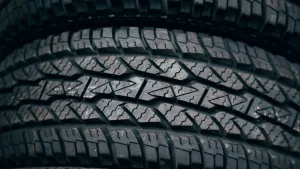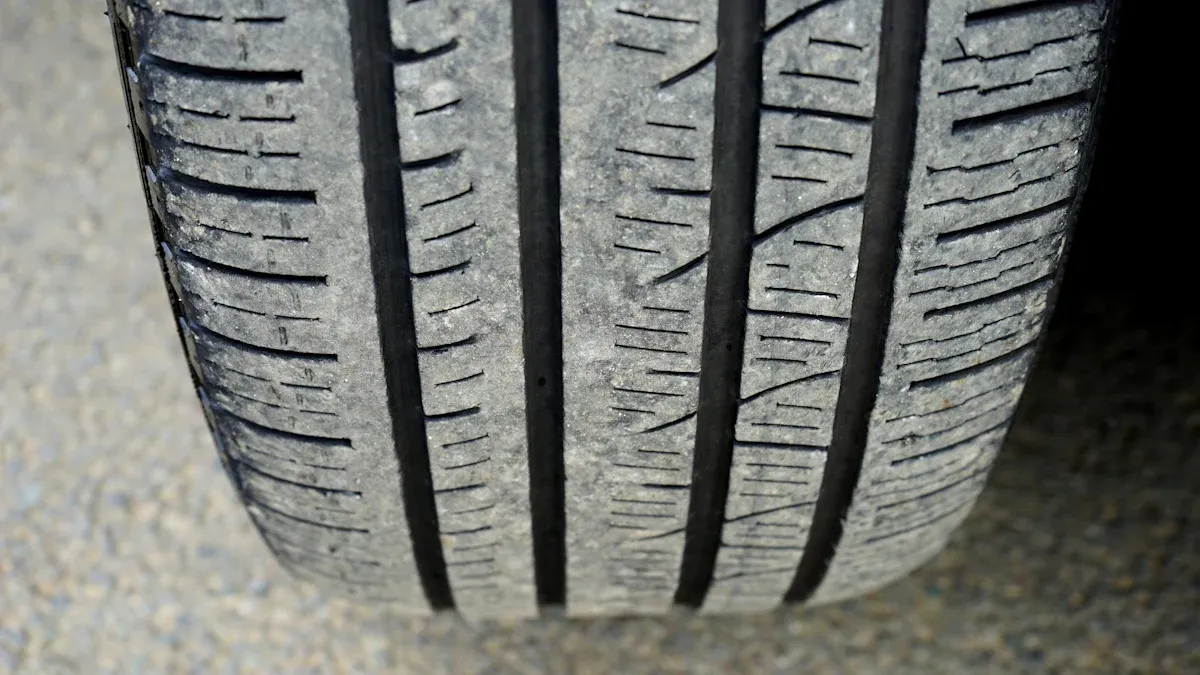
You protect yourself and others when you measure tyre tread depth with a tire tread depth gauge. Worn tyres cause thousands of accidents each year.
Vehicles with low tread depth have three times the risk of collisions.
About 9% of crashes involve tire issues.
Accurate tread depth checks help you meet legal requirements and keep your tyres safe.
Key Takeaways
Check your tires often with a tire tread depth gauge. This helps keep your car safe from crashes caused by worn tires. – Measure tread depth in a few places on each tire. Use a gauge that is set right for good results. This helps you find uneven wear early. – Change your tires before they get to the legal limit of 2/32 inch. This gives you better grip and shorter stops. It also helps you avoid tickets or problems with insurance.
Tire Tread Depth Gauge Basics
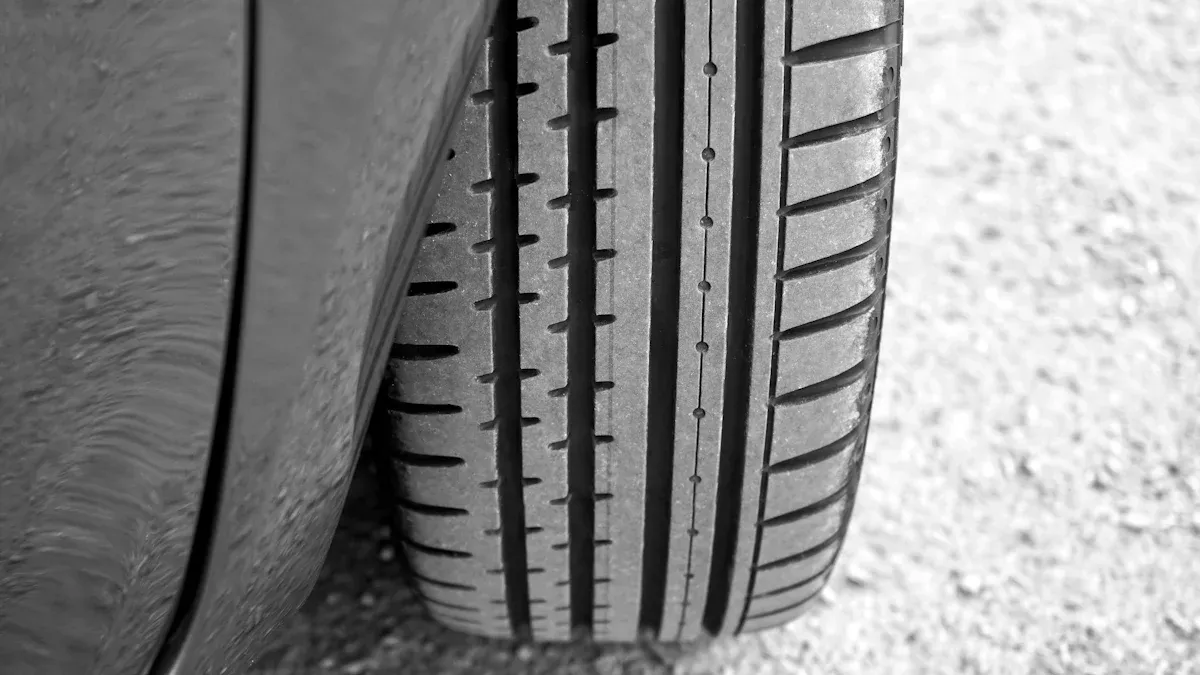
What Is a Tire Tread Depth Gauge
A tire tread depth gauge helps you see how much tread is left on your tyres. This tool is small and easy to use. It lets you check tread depth fast and gives correct results. You can pick a mechanical or digital gauge. Mechanical gauges have a probe and a scale. Digital gauges show numbers on a screen. They often give more exact results.
Here is a table that shows the main types of tire tread depth gauges:
Type of Gauge | Description / Notes | Accuracy / Precision | User Opinions / Comments |
|---|---|---|---|
Traditional Mechanical Gauge | Examples: Milton gauge, Slime color-coded version | Good enough for most people | Simple, cheap, easy to use, color coding helps |
Digital Caliper | Digital calipers with depth micrometer | Very accurate (up to 0.001″) | More exact, can be hard to use in small spaces |
Machinist’s Rule | Used as an alternative | N/A | Not common, but works fine |
Generic Inexpensive Gauges | Basic mechanical gauges, very cheap | Fine for normal use | Good for many, not hard to use |
Digital tire tread depth gauges show results right away. They help you make fewer mistakes. Mechanical gauges cost less and work well for most people. Both types let you check tire tread depth and keep your tyres safe.
Why Measure Tread Depth
You check tread depth to keep your car safe and follow the rules. Tread depth helps your tyres grip the road, especially when it rains or snows. Worn tyres can make your car slide and make it harder to stop. Look at this chart to see how less tread makes stopping on wet roads take longer:
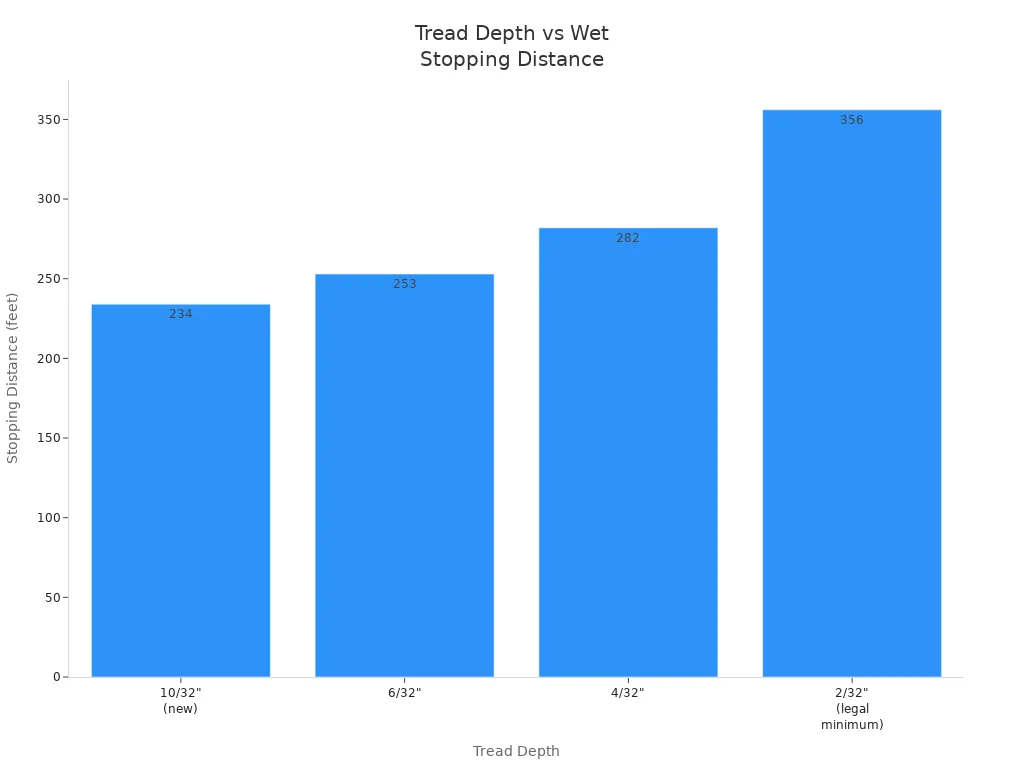
Check your tyre tread depth every month or before long trips. Experts say deeper tread helps you stop faster and stay safe. Checking often helps you find uneven wear, things stuck in the tread, or low tread before trouble starts. Many people look up “measure tyre tread depth” because they want safe tyres and do not want to get fined.
Tip: Change your tyres when tread depth is 2/32 inch. More tread means better grip and safer driving.
How to Use a Tire Tread Depth Gauge
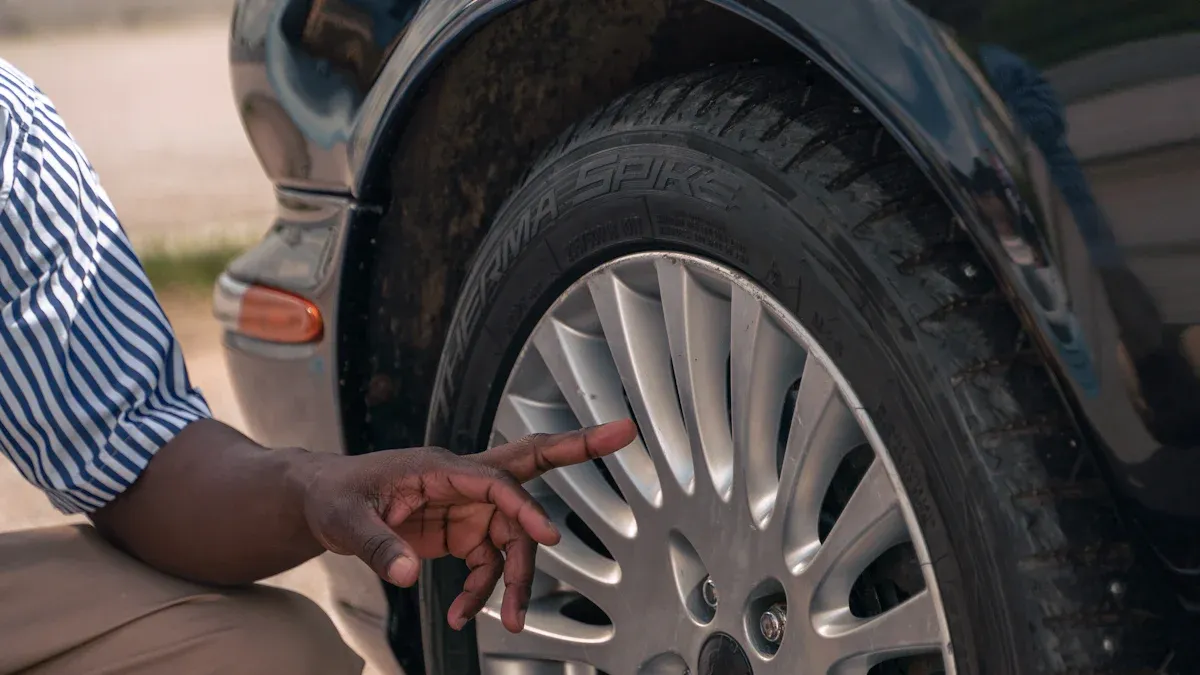
Calibrate the Gauge
Start with a calibrated tire tread depth gauge to get reliable results. Place the gauge on a flat, hard surface. Press the measuring pin down until it reads zero. This step ensures you get an accurate tread depth reading every time you measure tire tread depth. If you use a digital gauge, check the display for a zero reading. For a mechanical gauge, make sure the scale lines up at zero. Calibrate before each use, especially if you drop the gauge or notice odd results.
Tip: Always calibrate your tire tread depth gauge before you check tire tread depth. This simple step helps you properly measure tread depth and avoid mistakes.
Check Tire Tread Depth
You need to check tire tread depth in several places on each tyre. Tires wear unevenly, so measure tire tread depth in different grooves and across the central three-quarters of the tread width. Take measurements around the entire circumference of the tyre. Repeat this process for every tyre on your vehicle. This method helps you spot uneven tire wear and find the shallowest groove, which is often the most worn.
Measure tire tread depth in at least three spots, spaced about 15 inches apart.
Avoid measuring on raised surfaces or tire tread wear indicators.
Look for the lowest tread depth reading to judge tyre safety.
Measure Tire Tread Depth
Follow these steps to measure tire tread depth with your gauge:
Insert the probe of the tire tread depth gauge fully into the center of a main tread groove.
Push the gauge down until its base sits flat on the tread surface.
Hold the barrel and carefully remove the gauge without touching the measuring pin.
Read the tread depth on the scale or digital display.
Repeat this process at least two more times in different spots on the same tyre.
Average the readings for the most accurate result.
You can also use quick checks like the penny test. Insert a penny into the groove with Lincoln’s head down. If you see the top of his head, the tread is too low. For winter tyres, make sure you have at least 6/32 inches of tread depth for safe driving. Always measure tire tread depth in multiple grooves to detect uneven wear.
Step | Action |
|---|---|
1 | Calibrate the gauge on a flat surface |
2 | Insert probe into center groove |
3 | Press base flat against tread |
4 | Remove gauge and read measurement |
5 | Repeat in several spots |
6 | Average the results |
Avoid Common Mistakes
Many people make errors when they measure tire tread depth. You can avoid these mistakes by following expert tips:
Use a proper tool like a tire tread depth gauge or tread depth card.
Do not measure on tire tread wear indicators or raised bars.
Place the gauge perpendicular to the tread, not at an angle.
Check tire tread depth in several locations to spot uneven wear.
Keep your tyres inflated to the correct pressure. Low pressure causes uneven tread depth and misleading readings.
Rotate your tyres every 5,000 to 8,000 miles to promote even wear.
Inspect tyres for cracks, bulges, or foreign objects before measuring.
Use the penny test for a quick check, but rely on your gauge for precise results.
Note: Tread depth readings can be inaccurate if you measure on wear indicators or do not calibrate your gauge. Always measure tire tread depth in the main grooves and avoid raised surfaces.
Checking tread depth regularly helps you catch problems early. You keep your tyres safe and extend their life. If you see uneven tread depth or low readings, consider replacing your tyres soon.
Interpreting Tread Depth Results
Legal Minimums
You should know the lowest legal tread depth for your tyres. Most places say tyres must have at least 2/32 of an inch of tread. If your tyres are below this, you need to change them right away. Driving with tyres under the legal limit can cause big problems. You might get fined, lose your insurance, or put yourself in danger. Here is a table that shows the main risks and penalties:
Penalty/Risk Type | Description |
|---|---|
Legal Penalties | Fines up to £2,500 for each illegal tyre; 3 penalty points for each tyre; up to £10,000 and 12 points total, which can lead to a driving ban |
Insurance Implications | Insurance might not pay if you crash with illegal tyres, so you could owe a lot of money |
Safety Risks | Your car may not handle well, grip the road, or stop quickly, especially when roads are wet or slippery, making crashes more likely |
Vehicle Damage | Too much wear can hurt your car’s suspension and brakes, which can cost a lot to fix later |
If you drive a truck, you might not be allowed to drive until you get new tyres. This can slow you down and cost more money. Always check your tyres so you do not have these problems.
When to Replace Tires
Do not wait until your tyres are at the legal minimum. Many experts say to get new tyres when tread depth is 4/32 of an inch. At this depth, your tyres grip better and help you stop faster, especially when it is wet. Try the quarter test for 4/32 inch and the penny test for 2/32 inch.
Watch for these signs that mean you need new tyres or a mechanic to check them:
Feathering: tread feels smooth one way and sharp the other way
Cupping or scalloping: tread has high and low spots
Too much wear on the inside or outside edges
Center tread wear from too much air in the tyre
Bulges, cracks, or bubbles on the side of the tyre
Vibrations or humming sounds when you drive
These signs often mean your tyres have problems like being out of line or low air. Checking your tyres often helps you find problems early and keeps you safe. Remember, tread depth changes how your tyres work on the road. The way you drive, where you drive, and where the tyre is on your car all change how fast it wears out. Use your tread depth readings to help you, but also look for uneven wear and other warning signs.
Checking tire tread depth often helps keep your car safe.
Using a tire tread depth gauge helps you find problems early.
If you check your tires the right way, they last longer and you are less likely to have an accident.
Experts say more tread gives better grip and helps you stop faster.
FAQ
How often should you check your tire tread depth?
You should check your tire tread depth every month. You can also ask for free tyre checks at many auto shops.
Can you use the 20p coin trick instead of a gauge?
You can use the 20p coin trick for a quick check. A tire tread depth gauge gives you a more accurate result.
What should you do if your tread depth is low?
You should replace your tires if the tread depth is below the legal limit. Low tread depth increases your risk of accidents.
See Also
The Importance Of Regularly Inspecting Tire Tread For Safety

